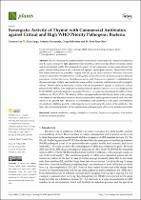Por favor, use este identificador para citar o enlazar este ítem:
https://repositorio.usj.es/handle/123456789/995
| Título : | Synergistic Activity of Thymol with Commercial Antibiotics against Critical and High WHO Priority Pathogenic Bacteria |
| Autor: | Gan, Cristina



Langa Morales, Elisa 
Valenzuela, Antonio Ballestero Fernández, Diego Pino Otín, Rosa 

|
| Palabras clave : | Thymol; Antibiotics; Synergy; Staphylococcus aureus; Streptococcus agalactiae; Acinetobacter baumannii; Natural product |
| Fecha de publicación: | 2-may-2023 |
| Editorial : | MDPI |
| Citación : | Gan, C.; Langa, E.; Valenzuela, A.; Ballestero, D.; Pino-Otín, M.R. Synergistic Activity of Thymol with Commercial Antibiotics against Critical and High WHO Priority Pathogenic Bacteria. Plants 2023, 12, 1868. https:// doi.org/10.3390/plants12091868 |
| Resumen : | The use of synergistic combinations between natural compounds and commercial antibiotics may be a good strategy to fight against microbial resistance, with fewer side effects on human, animal and environmental, health. The antimicrobial capacity of four compounds of plant origin (thymol and gallic, salicylic and gentisic acids) was analysed against 14 pathogenic bacteria. Thymol showed the best antimicrobial activity, with MICs ranging from 125 g/mL (for Acinetobacter baumannii, Pasteurella aerogenes, and Salmonella typhimurium) to 250 g/mL (for Bacillus subtilis, Klebsiella aerogenes, Klebsiella pneumoniae, Serratia marcescens, Staphylococcus aureus, and Streptococcus agalactiae). Combinations of thymol with eight widely used antibiotics were studied to identify combinations with synergistic effects. Thymol showed synergistic activity with chloramphenicol against A. baumannii (critical priority by the WHO), with streptomycin and gentamicin against Staphylococcus aureus (high priority by the WHO), and with streptomycin against Streptococcus agalactiae, decreasing the MICs of these antibiotics by 75% to 87.5%. The kinetics of these synergies indicated that thymol alone at the synergy concentration had almost no effect on the maximum achievable population density and very little effect on the growth rate. However, in combination with antibiotics at the same concentration, it completely inhibited growth, confirming its role in facilitating the action of the antibiotic. The time–kill curves indicated that all the combinations with synergistic effects were mainly bactericidal. |
| URI : | https://repositorio.usj.es/handle/123456789/995 |
| ISSN : | 2223-7747 |
| Aparece en las colecciones: | Artículos de revistas |
Ficheros en este ítem:
| Fichero | Descripción | Tamaño | Formato | |
|---|---|---|---|---|
| Synergistic Activity of Thymol with Commercial Antibiotics against Critical and High WHO Priority Pathogenic Bacteria.pdf | 2,58 MB | Adobe PDF |  Visualizar/Abrir |
Este ítem está sujeto a una licencia Creative Commons Licencia Creative Commons

